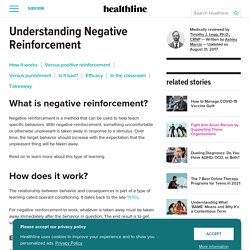

Definition of Reinforcement & Punishment. Reinforcement and punishment are often used as parenting tools to modify children’s behavior.

Let’s review the difference between positive reinforcement and negative reinforcement, and the difference in outcomes between them. The Difference Between Positive And Negative Reinforcement In behavioral psychology, reinforcement is the introduction of a favorable condition that will make the desired behavior more likely to happen, continue or strengthen in the future1. Because the favorable condition acts as a reward, reinforcement is a reward-based operant conditioning. Infographic Explaining Reinforcement & Punishment.
Video on Positive-and-negative reinforcement and punishment. Confusion of Negative Reinforcement with Punishment. Video clarifying Negative Reinforcement vs. Punishment. What is Negative Reinforcement. What is negative reinforcement?

Negative reinforcement is a method that can be used to help teach specific behaviors. With negative reinforcement, something uncomfortable or otherwise unpleasant is taken away in response to a stimulus. Positive Reinforcement vs Negative Reinforcement. Parents are responsible for the well-being of their children on a variety of levels.

This includes teaching them how to properly observe rules that keep them safe, support strong communities, and help them grow into productive adults who can work with others to achieve common goals. When a child misbehaves or chooses to ignore these rules, parents need to institute punitive measures to correct the behavior. There is an endless list of parenting philosophies that claim to show parents how to discipline their children in the most effective way.
Methods range from emotional coaching techniques that encourage children to recognize and logically analyze their feelings to old-fashioned corporeal punishments like spankings. How Positive Reinforcement Has the Power to Change Bad Behavior. Sometimes in the midst of the parenting chaos, we overreact to our child’s bad behavior in order to prevent it from happening again.

But then, we don’t make as big a deal about very small, yet positive behaviors kids engage it. And it sends a message to our kids. Definition of Positive Punishment and Examples. Positive punishment is often used in life when we want to suppress unwanted behavior.

Let’s examine its definition, usage and examples, especially when it comes to parenting. What is Positive Punishment Positive punishment is a type of operant conditioning, a theory proposed by psychologist B.F Skinner. Its main purpose is to reduce the likelihood of an undesired behavior repeating in the future by applying an aversive stimulus after the behavior occurs. Positive punishment in psychology is what we refer to as “punishment” in everyday life. Negative Punishment with Examples. In this article, we will review negative punishment, its definition, examples, and drawbacks.

American psychologist B.F. Skinner developed the theory of operant conditioning, which stated that a person or animal’s behavior could be increased or decreased by adding or removing appropriate stimuli after the behavior is exhibited. The difference between classical conditioning and operant conditioning is that classical affects unconscious behavior, while operant affects conscious behavior. Within operant, punishment aims to reduce a behavior while reinforcement increase a behavior. Why Punishment might not always work. 4 Types of Parenting Styles and Their Effects on Kids. Your parenting style can affect everything from how much your child weighs to how she feels about herself.
It's important to ensure your parenting style is supporting healthy growth and development because the way you interact with your child and how you discipline her will influence her for the rest of her life. Researchers have identified four types of parenting styles:1 AuthoritarianAuthoritativePermissiveUninvolved. Parenting Style Infographic.